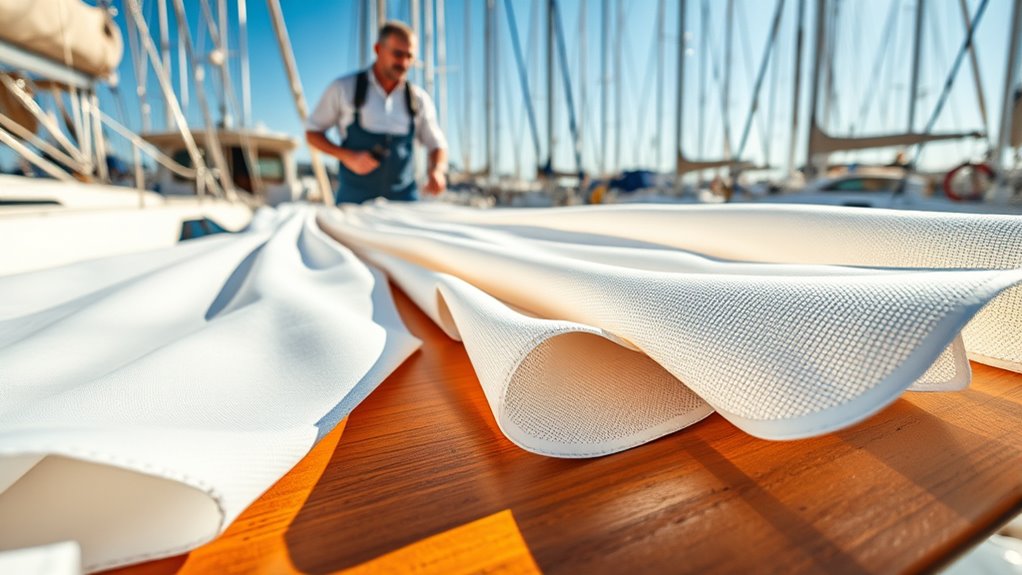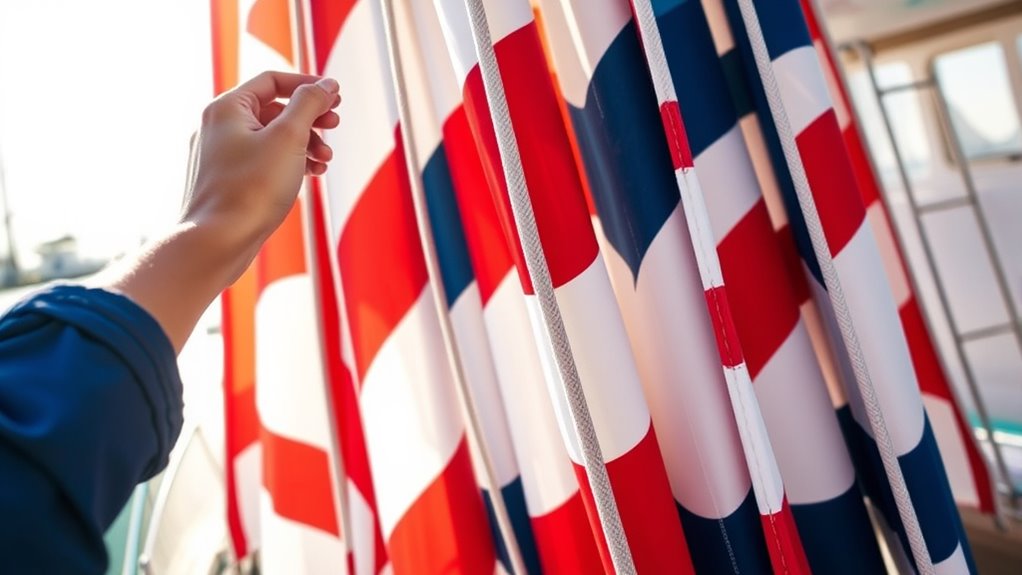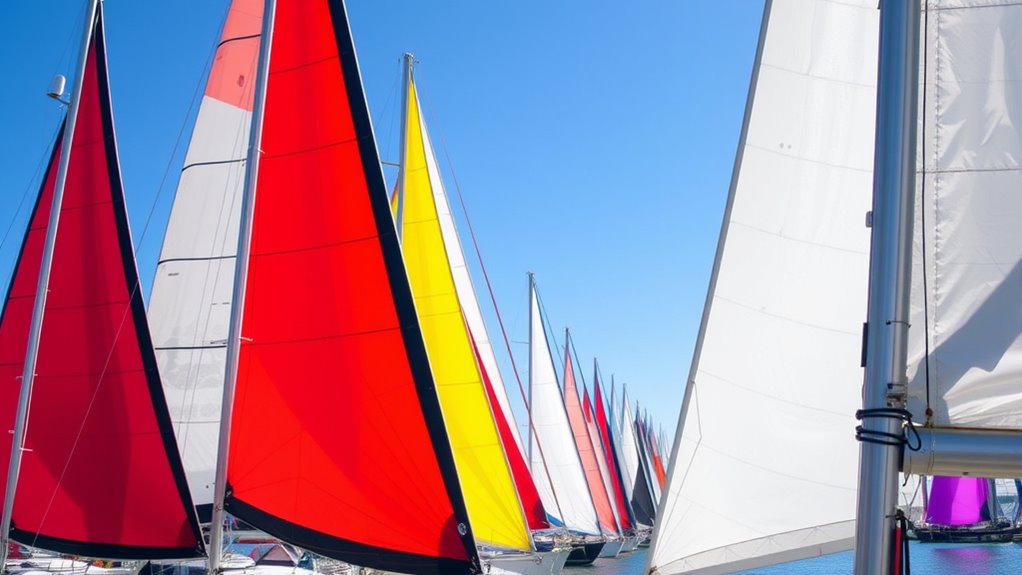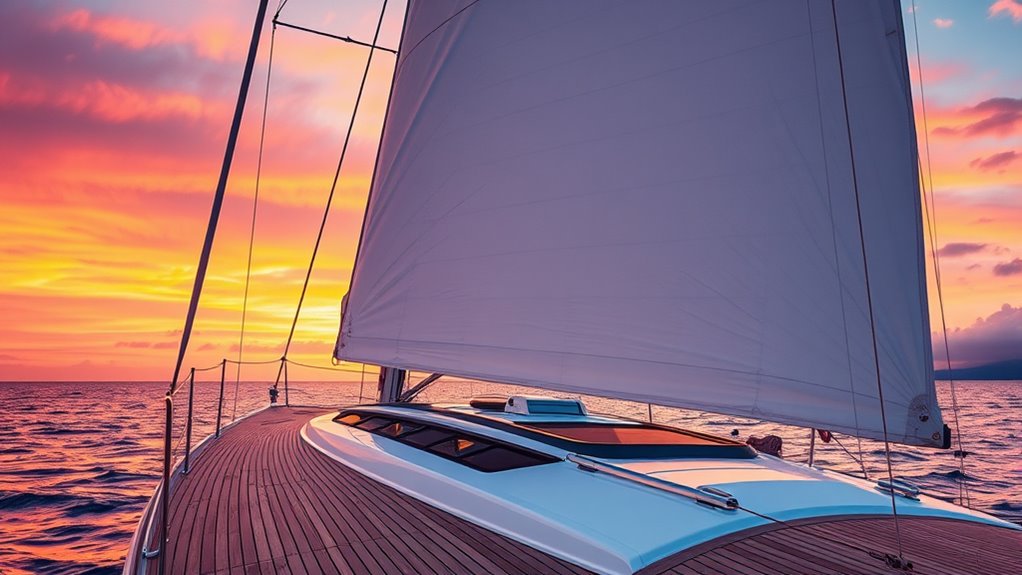When choosing sails for your sailboat, consider the material that matches your sailing style and conditions, such as durable Dacron for longevity or lightweight Mylar for performance. Match sail sizes and shapes to wind strength—smaller sails for strong winds and larger for light winds. Think about your budget and maintenance needs; investing in quality sails can save money long-term. Keep in mind that the right setup boosts safety, speed, and ease of handling—if you continue, you’ll discover how to optimize your sail selection for any adventure.
Key Takeaways
- Match sail size and shape to your boat’s design, typical wind conditions, and sailing purpose (cruising or racing).
- Choose appropriate sail materials based on durability, performance needs, and budget considerations.
- Consider local weather patterns and sea state to select sails that optimize safety and efficiency.
- Decide between new or used sails, factoring in maintenance, lifespan, and cost-effectiveness.
- Opt for professional installation and regular maintenance to ensure optimal performance and longevity of your sails.
Types of Sail Materials and Their Advantages

When choosing sail materials, understanding their different types and benefits helps you make an informed decision. Cloth sails, like Dacron, are popular because they’re durable, affordable, and resistant to stretching. They handle UV exposure well and are easy to maintain, making them ideal for regular use. Mylar sails, made from a polyester film, are lightweight and provide excellent shape retention, which boosts performance. However, they’re more delicate and prone to tearing. Spectra and Kevlar sails are incredibly strong and lightweight, offering high performance for racing. But they tend to be more expensive and can be less forgiving if damaged. Knowing these options allows you to choose a sail material that matches your sailing style, budget, and maintenance preferences effectively. Additionally, understanding toilet maintenance and repairs can help you keep your sails in top condition, ensuring longevity and optimal performance. Regular inspections and sail repairs are essential to address small tears or wear before they worsen, extending the lifespan of your sails. Staying informed about advancements in sail technology can also help you select the best materials for your specific needs. Incorporating knowledge about material durability can further guide your choice based on typical sailing conditions, and considering environmental factors can help you select sails that withstand varying weather patterns.
Common Sail Configurations and Their Uses

Understanding the most common sail configurations is essential for optimizing your boat’s performance and handling. The jib is a versatile sail placed forward, ideal for light to moderate winds and improving steering. The main sail is the largest, providing most of your boat’s power; it’s used in nearly all conditions. The mizzen sail is positioned aft on a ketch or yawl, offering better stability and control in heavy winds. The spinnaker is a large, balloon-like sail used for downwind sailing, maximizing speed. The storm sail is small and sturdy, designed for harsh conditions. Each configuration serves specific purposes, helping you adapt to weather, wind conditions, and your sailing goals. Knowing these setups allows you to choose the right sails for safer, more efficient sailing. Additionally, understanding sail material options can improve durability and performance in various conditions. Proper knowledge of sail configuration also helps in troubleshooting and adjusting sails during a voyage, ensuring optimal performance at all times. Being familiar with safety procedures related to sail handling can prevent accidents and enhance your confidence on the water. Furthermore, regular maintenance and inspection of your sails can prolong their lifespan and maintain their effectiveness. It’s also beneficial to familiarize yourself with regional weather patterns, as they influence sail selection and handling strategies.
Factors Influencing Sail Size and Shape

Several factors directly influence the size and shape of your sails, affecting how your boat performs under different conditions. Wind strength is a primary consideration; stronger winds call for smaller, more reefed sails to prevent overpowering the boat, while lighter winds benefit from larger sails to maximize power. Your boat’s design, including hull shape and rigging, also impacts *ideal* sail shape and size. The purpose of your sailing—whether racing or cruising—determines whether you prioritize speed or ease of handling. Additionally, your skill level influences how aggressive or conservative your sail choices should be. Local sailing conditions, such as typical wind patterns and sea state, further shape your decision. Understanding sail trim and its effects can help optimize your sail performance for different situations. Proper sail management techniques are essential for adapting to changing conditions and maintaining safety. Recognizing sail area considerations can also help in selecting the appropriate sails for your vessel’s performance. Being aware of personality traits can influence your approach to sail handling and decision-making, especially in challenging conditions. A thorough knowledge of sail material and its durability can additionally guide your choices for longevity and safety. By understanding these factors, you can tailor your sails for better performance and safety.
Matching Sails to Your Sailing Conditions

To get the best performance, you need to match your sails to the current wind conditions. Choosing the right sail material also makes a big difference in handling and durability. Let’s explore how wind compatibility and material selection can improve your sailing experience. Using appropriate sail materials can also help in controlling the amount of sail area exposed to the wind, optimizing speed and safety.
Wind Conditions Compatibility
Matching your sails to the wind conditions is essential for optimizing performance and safety on the water. When the wind is light, you’ll want sails that are smaller and easier to handle, like a furling jib or a lightweight main. These sails catch enough breeze without overwhelming your boat, giving you better control. In moderate conditions, a standard sail plan provides a good balance of power and maneuverability. For strong winds, consider larger, more stable sails or reefed configurations to prevent excessive heeling and maintain control. Matching your sails to the wind intensity helps you sail efficiently, reduces strain on your gear, and keeps you safe. Always assess current conditions before setting sail, and choose sails that match wind strength to ensure optimal performance. Using appropriate wall organization systems can help keep your deck clutter-free, making sail handling safer and more efficient. Additionally, understanding wind condition compatibility can help you select the optimal sail setup for various sailing environments, especially since airtight sails can assist in controlling airflow and pressure. Being aware of emerging sailing technologies can also enhance your ability to adapt to changing wind conditions and improve safety.
Sail Material Selection
Choosing the right sail material depends on the sailing conditions you’ll encounter. If you sail in strong winds or rough seas, you’ll want durable, high-strength fabrics. Lighter, more flexible materials suit casual or light-wind sailing. Consider the table below to match your needs:
| Sailing Condition | Recommended Material |
|---|---|
| Heavy winds and choppy seas | Dacron or laminated fabrics |
| Light winds or cruising | Polyester or Mylar |
| Racing or performance | Kevlar or carbon fiber |
| Long-term durability | Polyester or laminated fabrics |
Additionally, selecting the appropriate sail material can also involve understanding the versatility of hybrid bikes, as different materials can optimize performance and durability under various conditions. Being aware of material properties helps in choosing sails that will perform reliably over time.
Budget Considerations and Cost-Effective Options

When considering your sail budget, it’s important to compare material costs and choose options that fit your financial plan. You’ll also want to weigh the costs of DIY installation against professional help and consider long-term maintenance expenses. Making smart choices now can save you money and guarantee your sails perform well over time.
Material Cost Differences
Material costs for sails can vary considerably depending on the type of fabric and construction quality you select. Basic Dacron sails are usually the most affordable, making them a good choice if you’re on a tight budget or need a durable, low-cost option. Polyester blends and laminate materials tend to be more expensive but offer increased performance and longevity. High-tech fabrics like Kevlar or carbon fiber provide superior strength and durability but come at a markedly higher price. Keep in mind that better-quality materials often require less maintenance and last longer, which can save you money over time. Balancing your budget with your sailing needs is key. By understanding these differences, you can choose a sail material that fits your financial plan while meeting your performance expectations.
DIY vs. Professional Installation
Deciding between DIY and professional sail installation can substantially impact your budget and the overall quality of your sails. If you have experience and the right tools, doing it yourself can save you money and give you a sense of accomplishment. However, improperly installed sails may lead to performance issues or damage, which could cost more long-term. Professional installation guarantees proper setup, potentially prolonging sail life and optimizing performance, but it comes with higher upfront costs. Consider your skill level, available time, and the complexity of your sails before choosing. If you’re on a tight budget, a DIY approach might be appealing, but for critical sails or larger boats, investing in professionals can provide peace of mind and better results.
Long-term Maintenance Expenses
Long-term maintenance costs are a crucial factor to contemplate when choosing sails, as they can considerably influence your overall budget over time. Some sail materials, like Dacron, require less upkeep and tend to last longer, saving you money in the long run. Others, such as laminate sails, may offer better performance but can be more expensive to repair or replace. Regular inspections, proper storage, and timely repairs can extend your sails’ lifespan, reducing ongoing expenses. Investing in high-quality sails initially might cost more upfront but can decrease maintenance costs over time. Additionally, consider choosing durable fabrics and UV-resistant coatings to prevent premature deterioration. Balancing initial costs with anticipated maintenance expenses helps you make an economical choice that keeps your boat sailing smoothly without draining your budget.
Maintaining and Upgrading Your Sails

Ever wonder how to keep your sails in top shape and improve their performance over time? Regular maintenance and smart upgrades can extend their lifespan and boost efficiency. To do this effectively:
- Inspect sails after each trip for tears, chafing, or wear, and repair minor damages promptly.
- Clean sails with mild soap and water to remove dirt and salt buildup, which can degrade fabric.
- Store sails properly when not in use, away from direct sunlight and in a dry, ventilated space.
- Upgrade hardware or reinforce seams if you notice persistent issues or want improved durability.
Frequently Asked Questions
How Often Should I Replace My Sail Boat Sails?
You might wonder how often to replace your sailboat sails. Generally, sails last between 5 to 10 years, depending on usage, exposure to sun and salt, and maintenance. Regular inspections for tears, fraying, or UV damage help determine if they need replacing sooner. If your sails lose shape or performance, it’s time for new ones. Proper care, like rinsing and storing correctly, can extend their lifespan and keep you sailing smoothly.
What Are Signs of Sail Wear and Tear?
You’ll notice signs of sail wear and tear through fraying edges, loose or broken threads, and faded colors. Look for soft spots or thinning fabric, which indicate weakening material. Tears or holes can develop from rough handling or UV damage. If your sails don’t hold shape or you see uneven stretching, it’s time to examine further. Regularly check for these issues to ensure safe and efficient sailing.
Can I Customize Sails for Specific Sailing Styles?
You can definitely customize sails to match your sailing style. By working with sailmakers, you can choose materials, shapes, and sizes that suit your preferred conditions—whether you enjoy racing, cruising, or day-sailing. Custom sails optimize performance and comfort, helping you handle different winds and water. Just communicate your needs clearly, and the experts can craft sails that enhance your experience and match your specific sailing techniques.
How Do I Choose Sails for Racing Versus Cruising?
You might think racing and cruising sails are worlds apart, but both aim to make you enjoy sailing, right? For racing, you want lightweight, high-performance sails that catch every gust, giving you speed and agility. Cruising calls for durable, easy-to-handle sails that prioritize comfort and reliability. So, pick racing sails when winning matters most, and opt for cruising sails when relaxation takes precedence—after all, who says you can’t enjoy both?
What Safety Considerations Are There When Handling New Sails?
When handling new sails, safety is key. You should wear gloves to protect your hands from sharp edges and prevent cuts. Always check for loose fittings or tears before raising the sails. Use proper lifting techniques to avoid strains, and make sure the area is clear of obstacles. Communicate clearly with your crew, and never rush the process. Taking these precautions helps prevent accidents and keeps everyone safe while managing your sails.
Conclusion
Choosing the right sails can transform your sailing experience from ordinary to legendary. With the perfect materials, configurations, and sizes, you’ll conquer the seas like a true captain. Don’t settle for average—your sails are your most powerful tool, capable of turning every breeze into a thrill ride. Invest wisely, maintain diligently, and watch as your boat becomes a sailing legend. Get ready to make waves and leave everyone in awe of your epic adventures!










